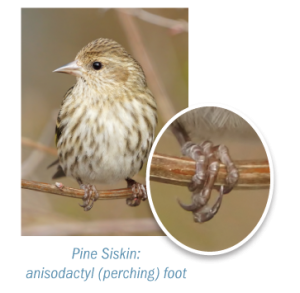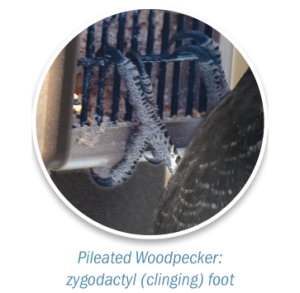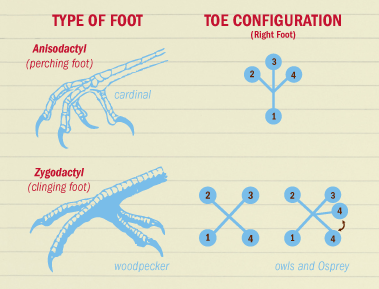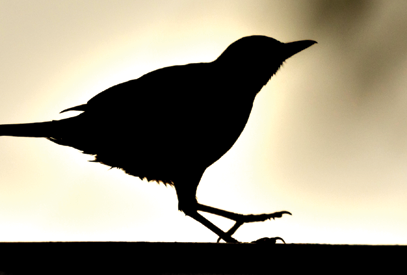Avian Multi-Tools
Pause to consider the functions required of various birds’ feet: perching, clinging, walking, swimming, preening, carrying objects, egg rolling, mating displays, and even heat loss regulation. It turns out that a foot’s functions emerge as an arrangement of the toes.
 The Toes Do the Work
The Toes Do the Work
Birds are considered digitigrade, which means that they generally walk on their toes, not on their entire foot. Most birds have 4 toes. How these toes are arranged will tell us a lot about their habits.
Toes of Perching Birds
Songbirds are considered perching birds. They have independent, flexible toes, with one facing backwards and three facing forward, best for grasping perches. This is called anisodactyl. When perching birds sit, a tendon on the backside of their foot automatically flexes, locking their toes around a perch, like a branch. When their feet are in this position, their toes are locked in place—so sleeping birds don’t fall. As the bird stands up, the tendon releases.
Toes of Water Birds
Water birds, like ducks, have webbing between their toes for swimming. Gulls also have similar webbed feet to provide more surface area for walking in soft mud near water. Wading birds, like herons, have long toes which help spread their weight over a large area to help walking on soft surfaces near the water’s edge. The Snowy Egret has bright yellow toes that it wiggles as lures to attract fish.
Toes of Raptors
Raptors, like hawks, eagles, and owls use their large claws to capture, kill, and carry prey with their feet. Owl feet are even more unique in that they can also rotate one toe forward, so they have three toes forward and one toe backwards for perching.
 Toes of Clinging Birds
Toes of Clinging Birds
The toes of clinging birds, such as woodpeckers, are arranged differently from perching birds. They have zygodactyl feet, which means that two toes face forward and two toes face backwards. Owls and most parrots also have zygodactyl feet. This foot shape allows these birds to climb up, down and along the trunk of a tree, and to hang upside-down.
With this zygodactyl arrangement, woodpeckers can access upside-down suet feeders while most other birds cannot. An upside-down suet feeder can eliminate suet raiders like Red-winged Blackbirds, starlings, grackles and crows, since they cannot cling upside down as easily as woodpeckers.
A “Hybrid” Foot
White-breasted Nuthatches hang upside-down, but do not have zygodactyl feet. Instead, you might classify nuthatches as perching/clinging hybrids: their toes are still arranged as a perching bird, but they have an extra large claw on one backward-facing toe that allows them to keep a grip better than most other perching birds.



